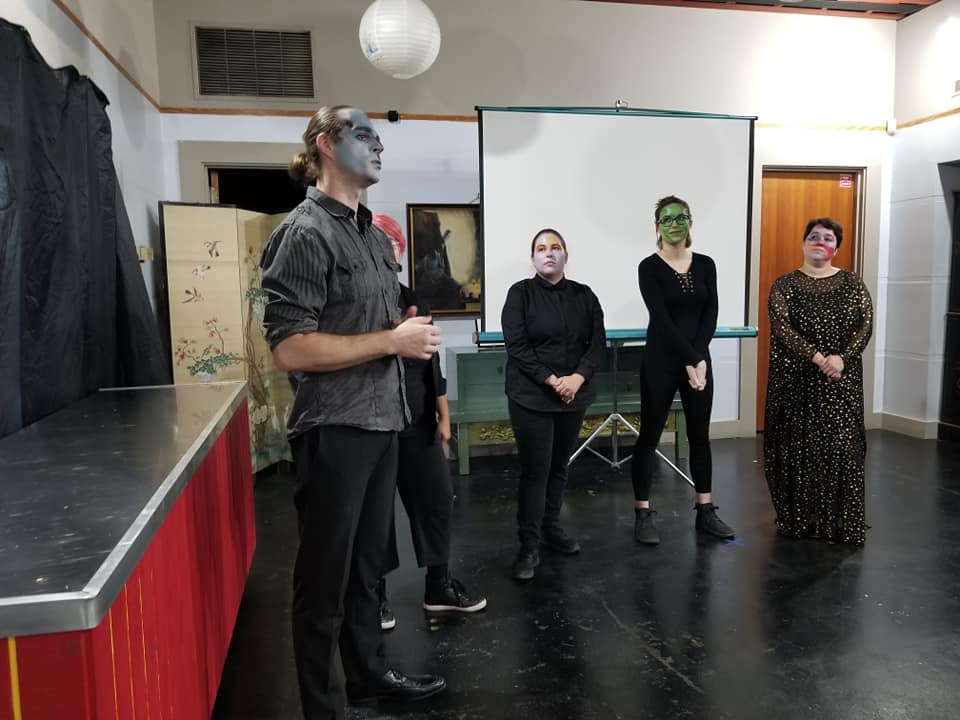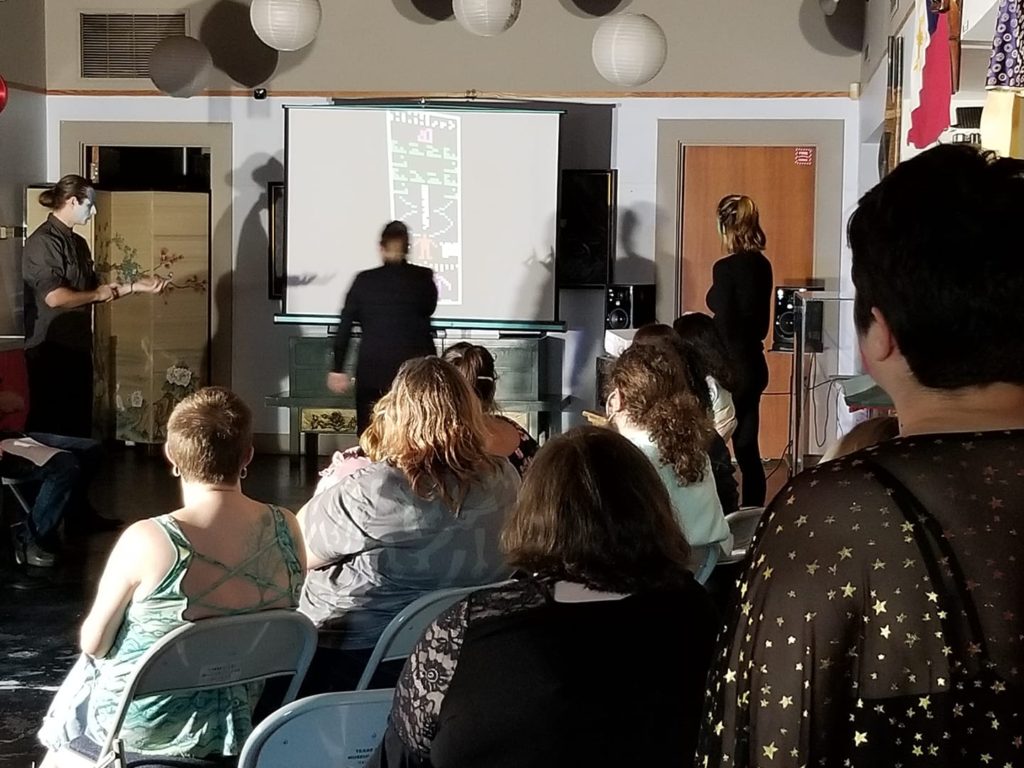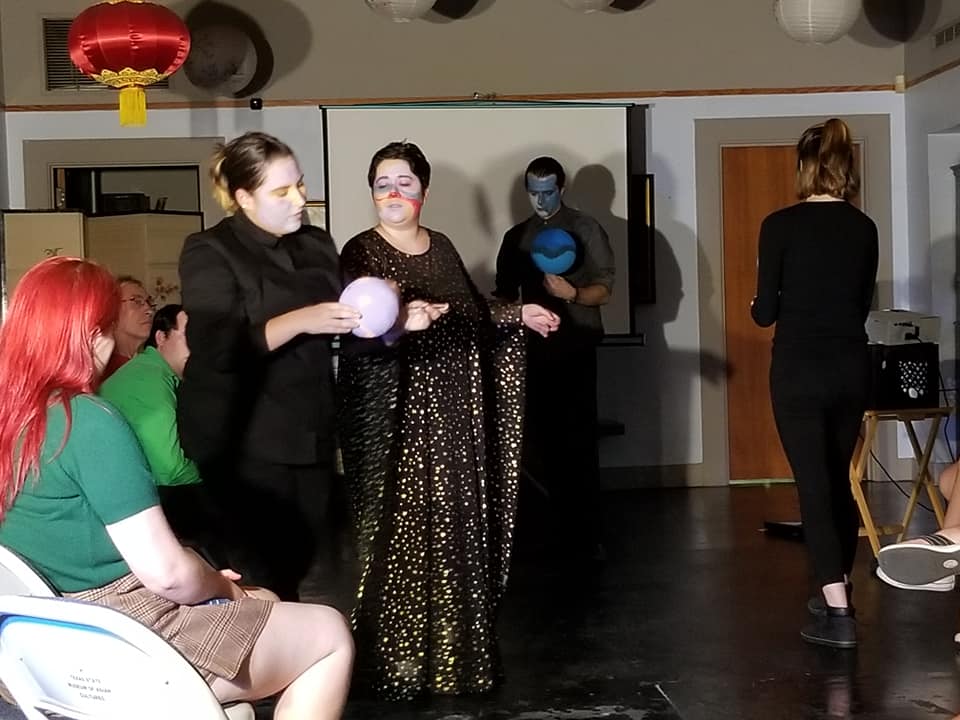Music Releases & Articles
- By Verderber
This page is dedicated to music-related covers, songs, and other assorted music goodies that we put together, write, or record for fun. We do not own copyright to song covers. You will also find short essays on theatre written by members of Zero Untitled.
***************************************************************
Circumventing the Geocentric: A Note on “Planetes: Extinction”
(by Michael Verderber. This essay was written to be read during the talkback/ Q&A at the Texas State Museum of Asian Cultures, but it was not read due to time constraints.) June 19, 2022.
When mounting a science fiction play, I ran into a huge problem that all of my research did not prepare me for. I had picked up several books on astronomy terms, theories, and events, and I quickly realized that these were all geocentric points of view – literally and metaphorically.
At first glance, this play appears like many other science fiction works in which several humans go to terraform, but “Planetes: Extinction” is not exactly about that. It is designed to bait the reader and audience into thinking so. But it is about an alien life form called the Valgar that are are doing that. The audience is baited into thinking they are human due to the commonplace tendency of sci-fi to be about humans. Even the number of syllables in each line of poetry are nine – same number of planets in our solar system. All design.

However, the issue became one of navigation. We know that sailors, much like the Valgarians, use constellations to help themselves navigate. That is where the geocentric view comes into play (as opposed to heliocentric). However, the Valgarians could not use constellations for their own navigation as it is an invention of humans from the physical viewpoint of Earth. Perspective-wise, where they are from (Terruh; another bait name), a constellation like the Big Dipper would look like nothing but random scattered stars, depending on what part of space they are entering our galaxy from. Thus, I could have made up constellations that they created, but that felt insulting to science and legitimate constellations. I opted for quadrants instead.
So, I felt this loss of terminology; I felt like I needed to avoid the problem by circumventing that sort of man-made language and man-made terminology all together. It did make the script feel science-less, but from the perspective of a life form coming in from beyond Pluto and heading towards Earth, it makes sense that things are quite backwards. Several man-made terms, ideas, machinations, and others had to be weighed: should I include this for the sake of science that a human audience would understand? Or do I omit it for the sake of the Valgarians’ point of view, who have never been in this galaxy before?

I thought that writing the syllables would be the most difficult part of the development process, as every line of the work is in strictly 9 syllables. But it was the conceptualizing science from another intelligent life forms’ perspective that proved to be the most difficult.
As you may have seen in the production, the actors mimed the usage of tools. We discussed the “alien” nature of these objects and tools. So, each actor was instructed to visualize and create a machine that their character would use for whichever task they were working on. On the second day of rehearsal, I stressed, “I don’t even want to know what your tool is!” I wanted to be as surprised as you may have been.

That notion brings me to the language and communication issues that the play brings to light. Through conversations with the production team, we talked at length one night that no matter how advanced we think we are as a human species, we still might not be able to communicate with another life form even at its the most basic level. Consider how many millions of species of animals there are on this planet alone. We cannot clearly communicate with any of them, but humans. Sure, we know what a dog’s bark might mean or what a cat probably wants when they rub up on our leg, but it is still not transparent communication. We are using conjecture to presume what they want: food, a walk, or attention.
That is just on a vocal and behavioral level. As one member of our crew mentioned: “plants talk” Presumably, what he meant was that flora and fauna use tacit modes of communication to assist each other, like how trees don’t entangle themselves with each other so that they can share equal lighting and nutrients. It’s called “crown shyness”. We have little idea how they just know that and how they communicate. So if we cannot even fully fathom crown shyness, we might be unable to to communicate with another species.
I suspect that when we do come in contact with another species, we might have the same communication issues we do with giraffes or any plants. Either their communication and language is so beyond our comprehension or we are beyond their levels of communication. It will probably be a matter of who lands on whose planet first. The smarter specie will prevail.
***************************************************************
The NEW Space: Working in a Zoom Theatre
by Michael Verderber
Due to the world’s recent quarantine, theatres around the world have been forced to enact their arts in a new medium – video. Namely, the application Zoom. For many of us who have been doing Zoom plays for well over a year, much of the following will definitely be tips you have already learned. Consider this a checklist for customization or opportunities to capitalize on all the application can offer you. However, for those fearful of trying theatre through Zoom, do give this document a read. The shows referenced have been staged by Zero Untitled and these productions can be viewed on YouTube (ZeroUntitledFilms) and on our main site www.zerountitled.com
- Are you acknowledging the cameras or not? In our productions of “The Job Interviews” and “The Church of Winter,” we acknowledge that this is a video call, but the audience is not addressed. In “Innocuous” and our Premature Punchline improv shows, we directly acknowledge an audience is watching our Zoom-based performance and encourage participation. The script will be the deciding factor, but a playwright needs to be loose in their writing to allow for the “issue” of a present camera.
- Remove/close all other apps that might be running. A no-brainer but easily overlooked. Often, we have had meetings and rehearsals where a social media notification would pop up and cause a mild interruption. Let us not forget about the lag issues that are caused when multiple apps and websites are open, which might draw away from fluidity of the most important app – the Zoom stage you are performing on.
- Take a second look at your lighting. Like an actual stage, let your lighting, desk lamp, or professional lighting rig create the ambience of your show, such as half-lit faces for “torn” characters, well-lit faces for comedies, an upstage lighting (from behind) for more dramatic purposes.
- Stage directions still apply. Are you standing? Then you already know about upstage and downstage. However, if you are seated, like many Zoom meetings: then use your upstage to fall back into your chair when frustrated, move downstage towards the camera for intense interest, lean left and right for apathy or interest, and so on. Use the space!
- Placement of eyes for emotions. This pairs with above. If your actor is struggling with staring at the screen/camera (which is very easy to do), then assign eye placement to emotions. These are spots from the actor’s view, not the audiences. For example, in our show “The Church of Winter,” the actress was instructed to look to her left at the doorknob in her house for apathy, to look DSR at her window sill for believing what the other character is saying, look up and above her camera when she is frustrated, etc. This may seem overly autocratic, but getting used to NOT looking at ourselves is important.
- Act around the edges. And speaking of off-camera, use the space to heighten and hide things. In the play “The Job Interviews: Annabelle,” a 5’8” actress was cast to play a four-year-old child. So, we sat the actress on the floor and only let her eyes and top of head be visible, leaving her entire body below the lens of the camera and out of view. It was humorous to see a tall female adult play a child, but it is even funnier to only see her “height” from such a tiny angle. It emphasized her facial and eye acting as that was all that was visible to the audience.
- The screen background is your set; treat it as such. As with the above tip, because the actress was not the predominate thing seen on screen, we had to place a chair covered in stuffed animals as the centerpiece of the play. That emphasized that this was the home of a child in the play. Likewise, in our production of “For Those Soft and Lonesome Times,” a lonely girl performs a monologue. The colorful posters the actress had up in her dorm would be too distracting, so we opted for figurines that are reflected in the script and gray objects, the same as her costuming. If this is all the audience gets to see, then give them something to look at that underscores the play, not distracts from it. Don’t forget to avoid copywritten images.
- Volume checks. With the play “Innocuous,” in which the actors ask the audience questions and vice versa, we had to go over volume checks with the audience. In character, the actors asked if everyone could hear them and for them to speak up as this show was participatory and immersive (even through Zoom). Not all audiences will want to speak up, so we suggest not spending too much time pulling their teeth, so to speak.
- Costuming. Like above and with any film and stage production, costume your characters that reflect their show. Don’t forget the necklaces and other accessories!
- Using vocal interrupters to get Zoom’s attention. With our production of “Innocuous,” the character used vocal interrupters, like coughs and “ums” to get the Zoom mic to pick them up and “switch” cameras to them. Depending on if your actors/audience are using “gallery mode” or not, this does help in redirecting the app to which character needs to be seen and heard at the moment.
- Remove staples during readings. Keep those page turns quiet during stage readings!
- Glasses reflection. This will take adjustment for you glasses-wearing folks. Move your light, computer camera, or your body to adjust. You might not be able to get rid of it entirely, but adjusting should help.
- Camera angles. This goes with the above. Adjust to fit the tone of the play. Faces too close look silly and nonchalant, straight-on look direct and business-like. Cameras set from below and shoot up towards chins look comedic while cameras shooting down make characters look innocent. Find what works for your play.
- The correct character name. For our shows, we use caps on character names: LINDA and REED, for example, to help tacitly distinguish character names from general audience members.
- Contingency plans for lost connections. We have imbedded contingency plans for all of our productions. For “The Church of Winter,” should the other actor have technical issues and get booted from the meeting room, the remaining character will improvise a monologue about the bad reception and chide themselves for screwing up the conversation they are in the middle of having. While this is happening, your techies/Zoom host can try to let the person back into the room. However, if the host gets cut off, then your performance is done.
***************************************************************
This recent batch of songs are for 2018’s March Music Month:
***************************************************************
DJ Oringe “Pummel”
Youtube: https://www.youtube.com/watch?v=I2dR1oRItfo
***************************************************************
 Katherine Orozco-Verderber “One Man Show” (Ariana Savalas cover)
Katherine Orozco-Verderber “One Man Show” (Ariana Savalas cover)
Youtube: https://www.youtube.com/watch?v=ZSnqJ6OL2P8&t=75s
***************************************************************
 Andrea Lorin & Robert Trujillo “Heaven K
Andrea Lorin & Robert Trujillo “Heaven K
nows”
Youtube: https://www.youtube.com/watch?v=GavN1-WC5Hk&t=1s
***************************************************************
d.I.M. “Waterfall”
YouTube: https://www.youtube.com/watch?v=GyD8XqeNB3w
***************************************************************








